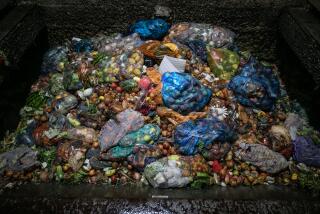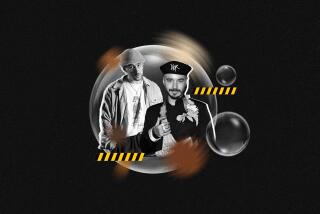With a Quick Blow, Her Future Dimmed
Going to school was supposed to give Gulnaz a better chance at life.
She had learned how to read, write and count, knowledge that could have helped break the bonds of ancient traditions that demanded that once she was grown she marry, bear children and stay at home.
Instead, like thousands of children across northern Pakistan who were about to start their Saturday lessons when the Oct. 8 earthquake hit, Gulnaz was almost killed by her school. It almost certainly ruined the 9-year-old’s life, leaving her maimed and alone. Her family was missing and presumed dead.
“Her society is destroyed,” said Ashfaq Sadiq, a software engineer and hospital volunteer who was caring for Gulnaz and other young quake victims. “She has no one. There is no authority, no police or any kind of system here, so anyone can come and say, ‘She is my relative,’ and take her onto the streets. In Pakistan, it is a common business.”
Not for the first time, Sadiq asked Gulnaz her family name. The yellow medical chart lying next to her head bore only her first name and a brief note on her surgery: amputation, right leg, below the knee. Gulnaz replied in a faint, trembling voice.
“It hurts,” she said, crying. “I want to go to my mom.”
“We will take you to your parents,” he told the girl softly, knowing that was probably a lie. She had just lost her leg. He couldn’t tell her that she was also alone.
The magnitude 7.6 quake was a calamity that especially hit kids who were learning. Many others who were outdoors working on village farms, cutting grass to feed water buffaloes or helping with other chores survived unscathed.
The quake destroyed or damaged at least 8,000 public and private schools in Pakistan’s North-West Frontier Province. More were reduced to rubble in the Pakistani-controlled portion of Kashmir, the worst-hit region.
Children make up roughly half the more than 6,000 patients being treated at the hospital here, a front-line emergency-care facility in North-West Frontier, surgeon Adeel Riaz said.
Pakistan is ill-equipped to help the injured recover or to protect them against exploitation by criminals. Children disabled and orphaned by the quake are vulnerable to gangs that run child beggar rackets, or traffickers who sell children into labor or sexual exploitation, child welfare experts warn.
“There are very big chances of abuse,” said Afshan Tehseen, head of child protection programs for Save the Children in Pakistan.
“At the moment, all we can do is contact government agencies and spread the word among other organizations that we should not let these things happen. There should be safe places for these children.”
Gulnaz was pinned for almost two days under rubble so heavy that it cut off the blood supply to her lower right leg. As the hours passed, her flesh began to die and gangrene spread.
When she was rescued and brought to a hospital here, doctors decided they had to amputate her leg quickly or the infection would enter her bloodstream and she would die.
Now Gulnaz is not only an amputee, but probably an orphan. Add that to the fact she is a girl, and there are three strikes against her in a poor, conservative society where a disabled person with little prospect of getting married, or supporting herself, is a burden few can afford.
So the shining promise of her life has gone dark. She is dazed, traumatized and lost. Whenever someone asks her father’s name, she only cries.
Her face was veiled with a blue mosquito net draped over her head, and Sadiq lifted it to try to calm her. Her black hair was tangled, her fingernails caked with dirt from her long ordeal beneath the rubble. She slowly opened her heavy lids, and her brown eyes were bloodshot from so many tears.
No one has begun to count the number of children whose limbs have been amputated, but doctors and aid workers expect it to be in the thousands.
Surgeons estimate they have removed limbs from more than 500 children at the medical college in Abbottabad, where Gulnaz lay in the first-floor children’s ward. It is one of several hospitals caring for the more than 65,000 people injured in the quake. The government’s official death toll is about 38,000 people, though independent estimates range much higher, with an untold number of orphans.
At the country’s best hospital, the Pakistan Institute of Medical Sciences in the capital, Islamabad, surgeons have amputated limbs from about 15 of more than 445 child patients seen in the first days after the quake, said M. Zaheer Abbasi, head of pediatric surgery.
“One child I especially remember, who was around 8 years old, had a very, very foul-smelling limb,” Abbasi said. “It was totally gangrenous, and she was unaccompanied. In the best interests of her health, we decided to amputate her without consent.”
But that hospital’s amputation rate is relatively low because a team of Russian doctors there who specialize in treating quake victims have sophisticated equipment to determine when limbs can be saved.
Most of the children requiring emergency care are hundreds of miles to the north, in hospitals where overwhelmed staff have only basic facilities and amputation is the best option.
“The number of gangrene cases is increasing day by day.... Lately we’ve had to amputate more and more,” Abbasi said.
The hospital is able to make only basic artificial limbs for the children, he added.
Pakistan’s government has set up a well-equipped hostel in Islamabad, but it houses just 11 children. Most patients are living in the quake zone, in makeshift tents and damaged hospitals, as Pakistanis slowly transfer them to better facilities with the help of eight U.S. military helicopters.
Private agencies can help some of them, but the country doesn’t have the facilities to care for and rehabilitate so many disabled children, said Mubarik Ahmad, the government’s director of child rehabilitation services.
Authorities have agreed to block adoptions to help prevent abuses, said Tehseen, of Save the Children. But young people disabled by the quake face a life of discrimination, she said.
“Disabled children are very, very badly treated,” she said. “Even if they go to school, they are treated badly because kids in the first grades tease them and call them different names. Even the teachers, though they are sympathetic in one way or another, still call them by these names.”
Sadiq said he knew more than 100 people who traffic in Pakistani children for forced labor and sexual abuse.
“The police are corrupt,” he said. “The government is not taking any kind of action.”
Riaz said he had alerted authorities to the dangers of child trafficking and that over the weekend they ordered that no children separated from their families were to leave the hospital, even if their treatment was complete.
But every day, powerful aftershocks rattle the hospital’s unstable walls, and anyone who is able to runs from the building, leaving patients like Gulnaz alone and vulnerable, Sadiq said.
“When I first saw her, she was like my sister, or my cousin,” he said. “I thought to myself, ‘She has no one, so I should help her.’ ”
The emotional strain of carrying the bodies of many of the 346 children found in one destroyed school, and sleepless days of trying to protect the living, showed in his troubled eyes.
He had been working 36 hours straight. But he couldn’t bear to leave Gulnaz on her own.
“Who will take care of her then?” he asked.
More to Read
Start your day right
Sign up for Essential California for news, features and recommendations from the L.A. Times and beyond in your inbox six days a week.
You may occasionally receive promotional content from the Los Angeles Times.






